Usually, I compare the JAMSTEC forecast with the NOAA forecast after NOAA Issues its Seasonal Outlook. But this month, JAMSTEC was very early so I thought I would share it with everyone now. NOAA calls their predictions an outlook but JAMSTEC calls their predictions a forecast. You need a scorecard. I am going to show their forecasts by month and by season and some of the indices they use in their model. They make world forecasts and for any readers who do not realize it, the U.S. is part of the world so it is covered by a world forecast. Of the season that includes our monsoon, I will extract and enlarge their forecast for North America.
I like the JAMSTEC forecast because the U.S. is part of the world and our weather is not independent of the worldwide weather pattern. In fact, most of U.S. weather originates in the Pacific Ocean and the Pacific Ocean is where Japan is located. In fact, Japan and the US jointly manage the monitoring system along the Equator that helps predict the phases of ENSO. So one of the reasons I include worldwide forecasts in articles is to encourage the understanding of worldwide weather patterns. It is not that the U.S. does not cooperate with other nations with respect to weather forecasts as it does. But to view weather forecasts on the Internet or TV you would not easily notice that.

For Introductory purposes, I should describe what JAMSTEC is
JAMSTEC | Japan Agency for Marine-Earth Science and Technology
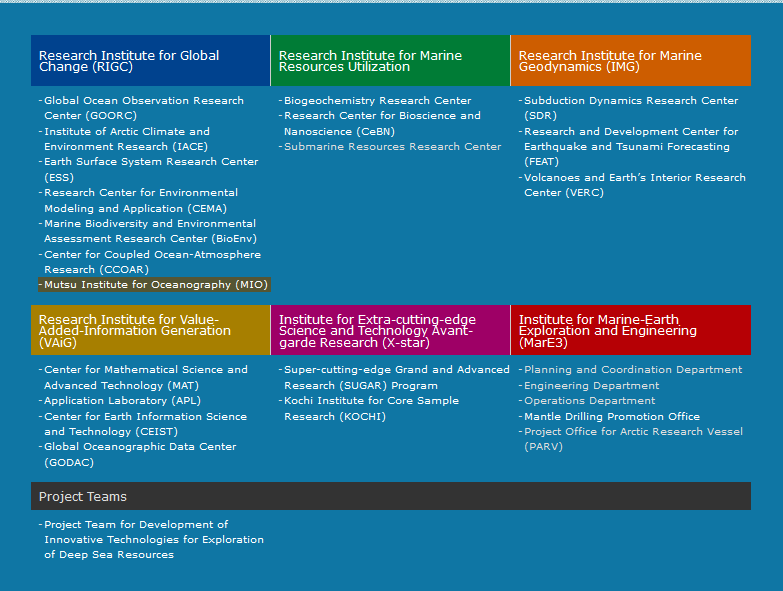
It is not a huge organization like NOAA but it does a lot of things much of which are related to ocean research. It is not the weather forecasting agency for JAPAN but issues this worldwide forecast as part of its research program. Some information on their model can be found by clicking Here
I will begin with the three short-term monthly forecasts
There are now a number of options for which version of the JAMSTEC model to use. I am using the version associated with the PDF of the results sent to me. But it may not be the best choice when one is focused on CONUS and the other versions are now available since the JAMSTEC website is not up and running. That is an issue that one faces with the use of any weather forecasting model. There really has not been enough experience with this updated model to know which version works best for different parts of the world.
May, 2022

Then June, 2022
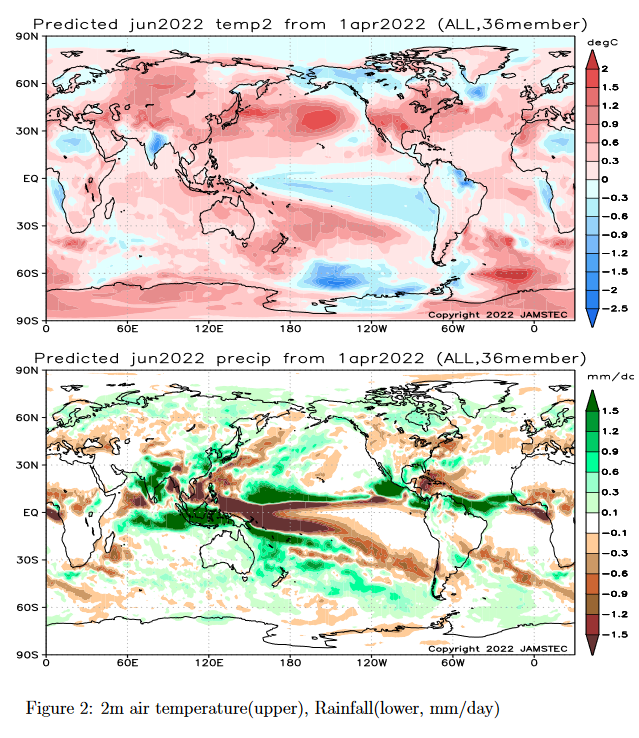
Then July, 2022
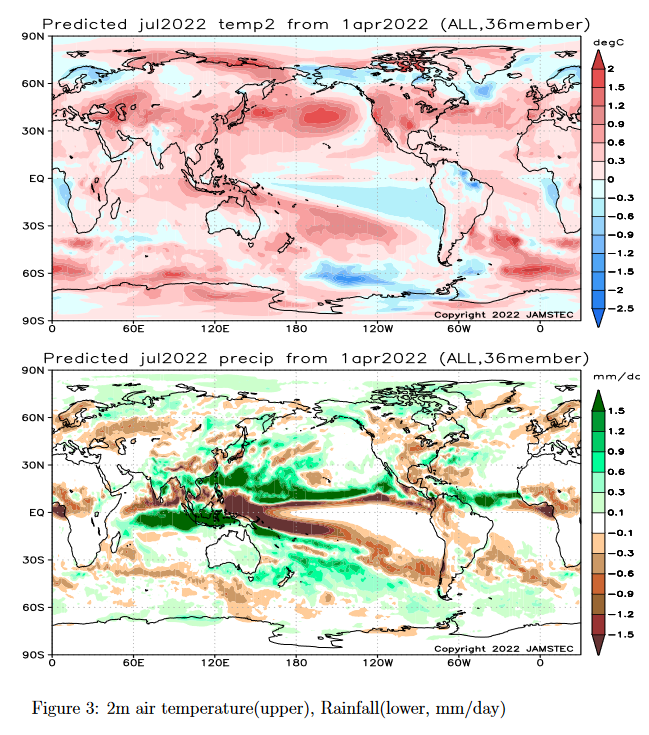
Then we shift to the two seasonal forecasts
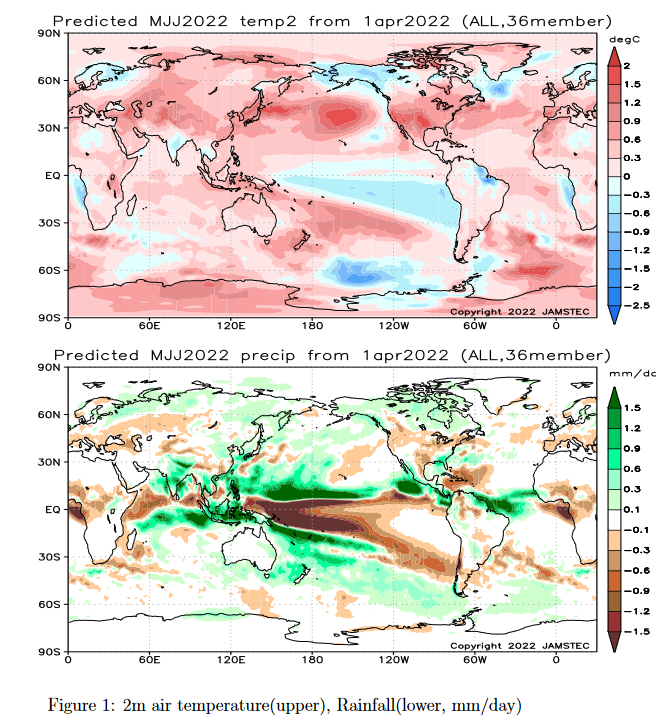
The JAMSTEC discussion below describes this map but it is meant for AMJ not MJJ so it would not be perfect but probably pretty good. But you can look at the map and see where it is warmer or cooler than usual and drier or wetter than usual. Europe looks dry which will if it works out this way compounds the predicted grain shortage caused by Russia invading Ukraine.
India looks pretty wet but MJJ is before the IOD turns negative.
And SON 2022
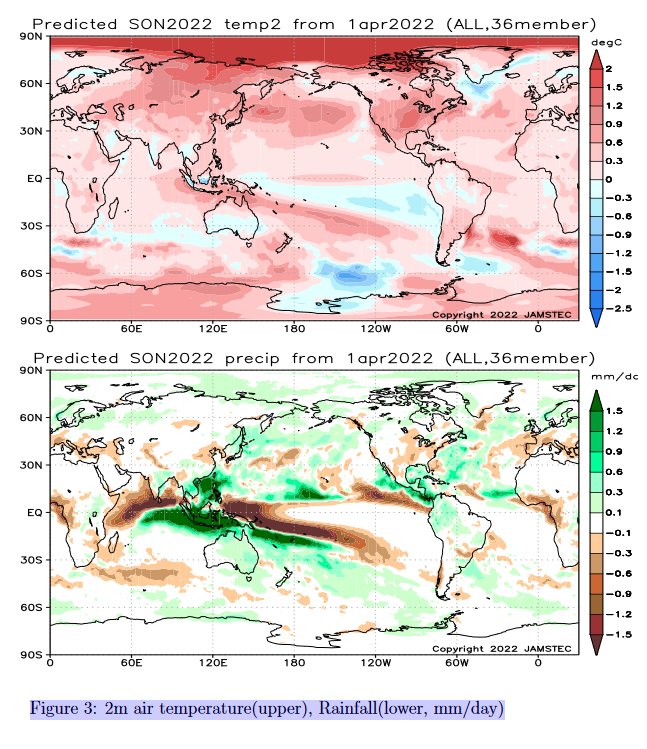
Again the JAMSTEC discussion would apply but one can read the map as well as they can. India looks mixed so that ties in with the forecast of a negative IOD and part of SE Asia looks really wet but Europe still looks dry. Australia is wet. What is called the Maritime Continent is very wet. We will talk about the North American Monsoon (NAM) later but CONUS looks dry except for coastal regions along the Gulf of Mexico. I wonder what that means. Parts of Africa look really dry also. Hawaii looks dry. Central America looks wet. Certain mines there will be flooded. But we are not discussing underground silver mining tonight but boots are probably a good idea.
At this point, I extract the precipitation forecast for North America (but you can see the same information in the world maps. I have just been able to enlarge part of those maps a bit. If I enlarge them too much, they will get blurry.
This is MJJ (I could have shown the impact of using different options with respect to the new forecasting model but I thought that would be too confusing). Notice the wet Southeast. Also notice that in the run-up to the North American Monsoon (NAM), in the Southwest it is wet to the west and dry to the east with Texas being especially dry.
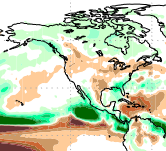
This is SON. That includes the last month of the NAM and represents meteorological Fall.
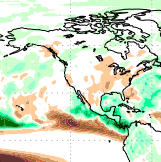
I would like to have JAS but that was not provided so one has to look at both with perhaps more emphasis on the top one but both show a poor NAM. But notice the difference from west to east. They are showing a wet Sea of Cortez so they are suggesting that Arizona will do better than New Mexico. They made a similar forecast last year and were wrong.
I suspect that NOAA will disagree and probably turn out to be more correct but we will see.
Now we look at the ENSO assumptions used.
We start with the forecast of Sea Surface Temperature Anomalies (SSTA).
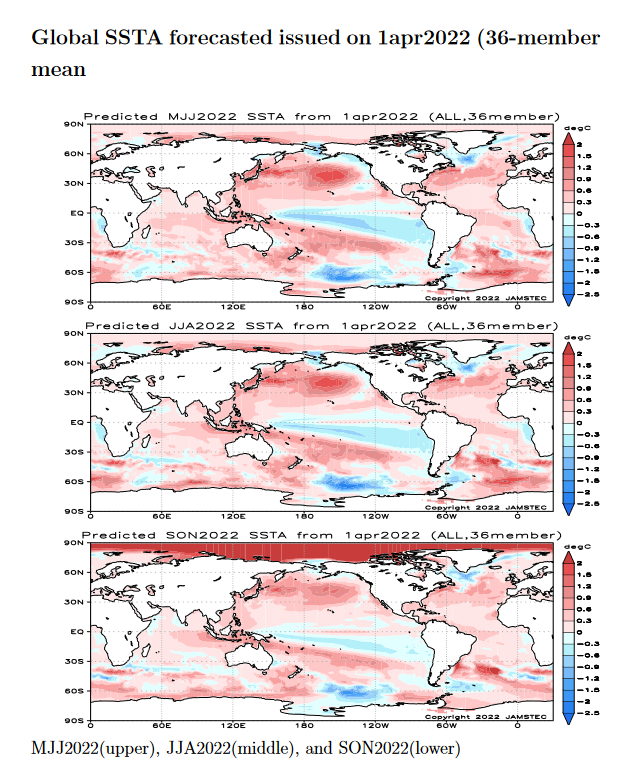
You can see the La Nina. It is the blue area along the Equator in the Pacific. The three time periods shown are a bit confusing as the first two overlap. You can see the La Nina fading and even the beginning of an El Nino. We do not have the NOAA Outlook yet but it will be different than what JAMSTEC is forecasting.
Data is Interesting.
The above is the better way to look at data but most people prefer to reduce an image to a single index even though that is a ridiculous thing to do, but we humans are lazy and want to keep things simple. Doing so also allows one to show a longer period of information so that is what is shown below. One specific part of the Equatorial Pacific is called Nino 3.4 and below is the recent record of that area states as a single index and to the right are the various model runs of the JAMSTEC Nino 3.4 forecast model. There is a lot of scatter but the general direction for most of the model runs is similar and if you have no better idea on how to interpret a bunch of model runs, you take the mean and that is shown although the color-coding leaves something to be desired.
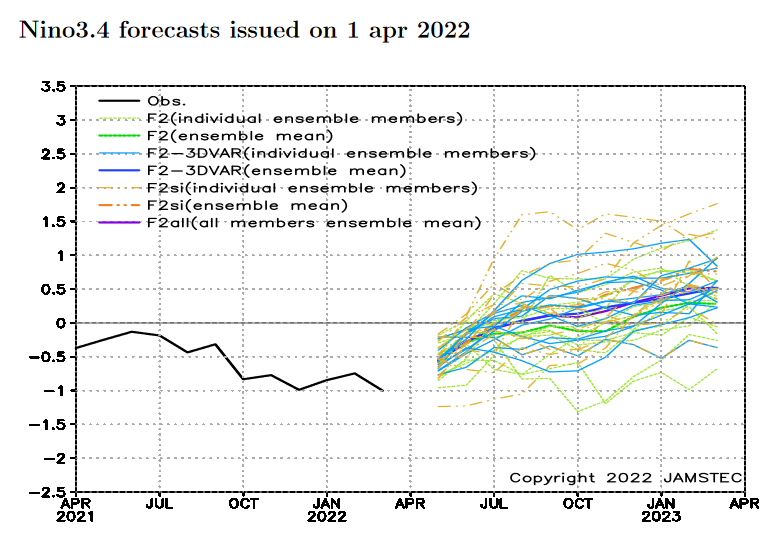
This shows La Nina ending very soon unlike the perspective of NOAA.

JAMSTEC has a separate model to forecast what they call a Modoki. I have discussed this many times and for now, let’s just say they look for sea surface temperature anomalies that are farther west than was is looked for with regards to a standard El Nino or La NIna. This model shows a slower exit of La Nina.
The standard JAMSTEC model is interesting because it almost seems to be forecasting a transition to El Nino (Nino 3.4 temperature anomaly reaching and exceeding +0.5C). Perhaps that is why they did not forecast the third season. The Modoki model is confusing to me as I do not see it really showing the La Nina becoming more of a Modoki type before it fades away but it also does not suggest the formation of an El Nino. These are busy graphics as they show a lot of information from different runs of the SINTEX model. F2 means it is the newer version, not F1. The 3DVAR is the new feature where the temperature of the various depths of the oceans is incorporated into the model. “si” stands for their new sea ice model. What we are interested in is the mean of the various runs and the tighter the distribution the more confidence we would have with the result. The standard Nino 3.4 forecast looks good based on those criteria. The Modoki forecast is not as tight but you still can see what the overall pattern is.
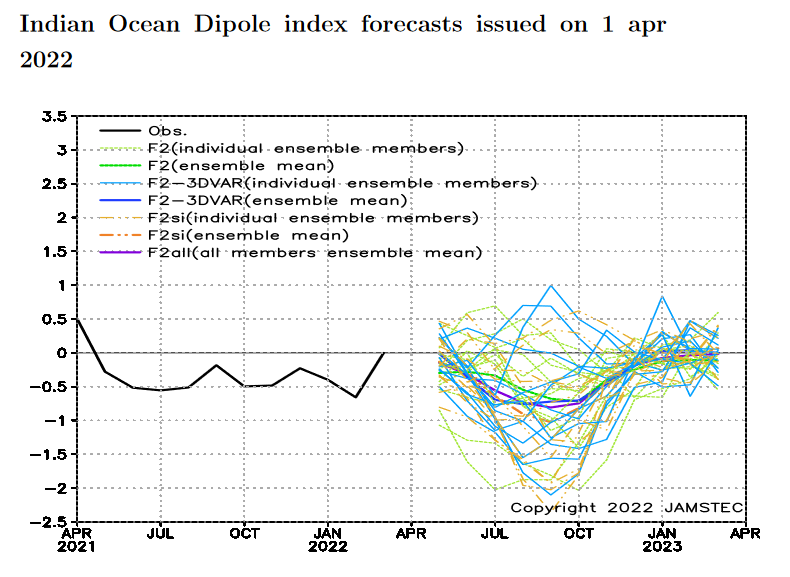
JAMSTEC is forecasting a brief IOD negative situation. You can see that on the graphic for July through October. A negative IOD increases the chances of above-average winter-spring rainfall for much of Australia and a poor Monsoon for India.
Here is the short JAMSTEC discussion
ENSO forecast:
The La Niña-like state is still observed. The SINTEX-F predicts that the La Niña-like state will weaken later, and then decay in boreal early summer. [So they reallly disagree with NOAA on the persistance of the La Nina][“Boreal” means nothern hemisphere when used in meteorology. If really means forests]
Indian Ocean forecast:
A neutral-state is now observed in the tropical Indian Ocean. The SINTEX-F predicts that a negative Indian Ocean Dipole will occur in boreal late summer. However, there is a large uncertainty in the prediction.The Ningaloo Niño is still observed. The SINTEX-F predicts that the Ningaloo Niño will decay in austral mid-autumn.
Regional forecast:
On a seasonal scale, the SINTEX-F predicts that most parts of the globe will experience a warmer-than-normal condition in April–June average, except for Alaska, western Canada, northern part of the South American Continent, and some parts of Indochina, India, Northern Europe, and southern Africa. In boreal summer (austral winter), the model still predicts most part of the globe will experience a warmer-than-normal condition, except for Alaska, western Canada, northeastern part of the South American Continent, India, and Northern Europe.
As regards to the seasonally averaged rainfall in April–June average, a drier-than-normal condition is predicted for southern coastal regions of Alaska, most part of U.S.A., the South American Continent, northern Mediterranean, some parts of the Middle East, and southeastern parts of China. In contrast, most part of Canada, Mexico, Central America, Brazil, Australia, central Africa, Scandinavia, India, Sri Lanka, Indochina, Indonesia, Philippines, some parts of China, the Korean Peninsula, and some parts of Eurasia will experience a wetter-than-normal condition.
In boreal summer (austral winter), a wetter-than-normal condition is predicted for Alaska, some parts of Canada, Mexico, Central America, Venezuela, Guyana, eastern Australia, some part of central Africa, India, Sri Lanka, Nepal, Indonesia, most part of Indochina, and some parts of China, the Korean Peninsula, and some parts of Eurasia. In contrast, most part of U.S.A., the South American Continent, some parts of West/Central Africa, most part of Europe, Philippines, and some parts of Eurasia will experience a drier-than-normal condition.
The model predicts most part of Japan will experience a warmer and drier-than-normal condition (except for northern Japan) in April–June average. The model also predicts persistence of a similar condition in boreal summer.